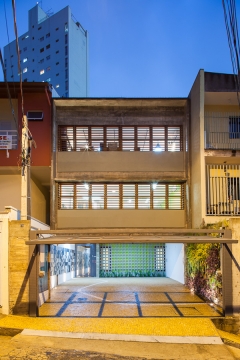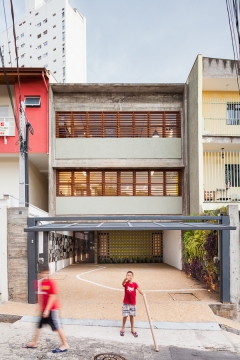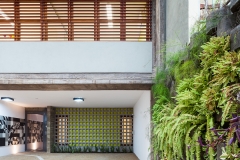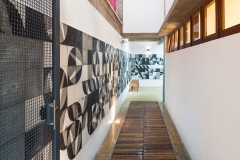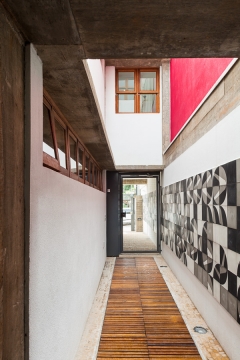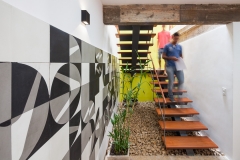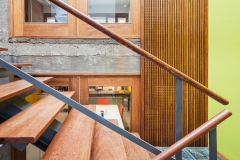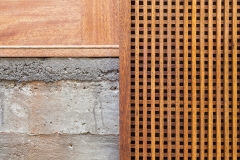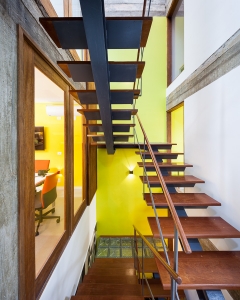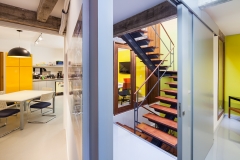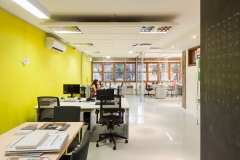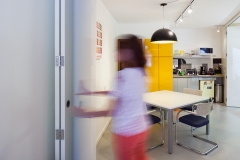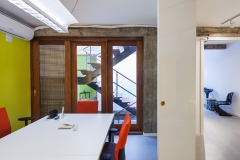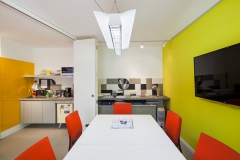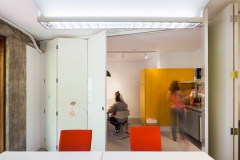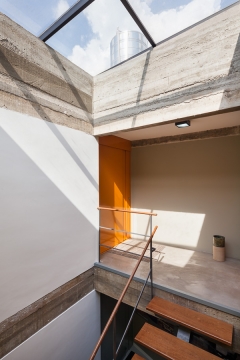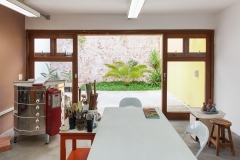We have named it Yucca Home Office from the moment we thought about the construction of a space that could shelter several companies or self-employed professionals who wished to work close to home in an environment that looked like home. Thus, we have joined materials that reminded this atmosphere: Portuguese stone floor, hydraulic tiles, lots of wood, a light staircase, a yard with garden, all inserted in a block of a neighbourhood with children playing in the street with a plaza two blocks away.
The Yucca has inhabited our imagination because in Ibiúna, where we have a house, there are thousands of maritaca bird nests in Yucca bushes, and they are not simple nests, they are actual condominiums, well within the concept of what we have dreamed of doing with this home office.
We have planted a Yucca in Joana’s backyard, she is the ceramist installed at number 04, in order to fix the starting reference of ideas.
the land
The land I found in the Vila Madalena station area, narrow and long, turned to the area of the neighbourhoods of Sumaré and Pompeia, has an extremely steep slope, which forced the construction of three retaining walls to fix the work on the ground.
In the project, these retaining walls should celebrate the steps we go up in the land; therefore, we have separated special claddings for them: hydraulic tile or wood stone in rachão format marking each floor.
the stream, the spring and the houses
The stream Água Preta runs through the slope and joins a spring close to the staircase of the house. This stream is now 100% underground and joins other streams to flow into the Tiete River. Part of the hydraulic design predicts the future use of this water to irrigate the gardens, but we have not finalized this stage yet.
The existence of the high water level in the land led us to deep foundations, causing extra care with the neighbourhood already present in the street for years.
There are neighbouring houses with small farm characteristics; during the day, we work with roosters crowing across the street, thus, we had to respect the topological profile of the street when inserting our house. Height, setbacks, everything should be in accordance with the neighbours.
tiles and concrete
The hydraulic tile is a striking element in the work, it plays with the symbol of Vernare in various compositions, respecting the guidance of never reversing the "letter V", representative of our symbol, and it became the finish of two of the three retaining walls. Due to its characteristics and porosity, it helps to contain and minimize the earth breathing behind these retaining walls.
The exposed concrete is the trace of São Paulo’s timeless architecture. It appears in the structures and in the decorative brick block on the ground floor, allowing some doubt concerning the purpose of the house: is it a home, is it an office?
tenants and coworking
We respect the different needs of tenants, but overall the environments seek informality, enjoying the exposed structures, without the need for continuous ceilings or masonry to block the rooms. I think the greatest exception is on the ground floor: a psychologist needed a more accurate acoustic comfort, hence the inclusion of plaster ceiling and reinforced drywalls between rooms, and partially behind the decorative bricks of the facade.
The ceramist and the press officer walked more in line with the interior of the Vernare office, which occupies the first floor. In fact, Vernare assisted these tenants with the occupation and the interiors.
It was also a premise to make the house a space of coworking experience where everyone could enjoy the best ambiances for pantry and meeting rooms, both in the "basement" of Vernare.
And it has been happening, increasing the integration sensation of the floors and people, living an almost "domestic" experience, our main goal with the Yucca home office.
Designer’s credits:
Architecture and management: Vernare Projetos Ltda.
Team: Maria Ines Jabur Zemella, Luciano Soares de Oliveira, Kelly Floreste
Interns: Luana Broner, Julia Jabur Zemella, Gustavo Stehling
Mural design: Julia Jabur Zemella
Structure, hydraulics and electric: RM6 Engenharia
Lighting: Vernare Projetos
Foundations: Constrauss
list of suppliers:
Cover: Cerâmica Taguá
Vernare’s flooring: NS Brazil
Frames: Bras Real Esquadrias e Madeiras
Joinery: Labry Móveis
Glass and glass cover: WRahal Vidros
Hydraulic tiles: Rochbeton
